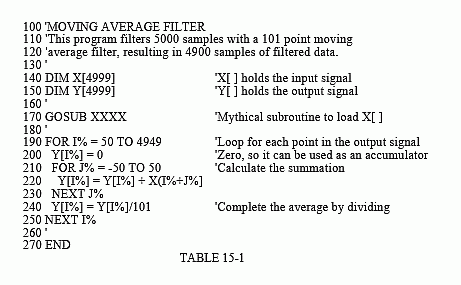The Scientist and Engineer's Guide to
Digital Signal Processing
By Steven W. Smith, Ph.D.
Book Search
Table of contents
- 1: The Breadth and Depth of DSP
- 2: Statistics, Probability and Noise
- 3: ADC and DAC
- 4: DSP Software
- 5: Linear Systems
- 6: Convolution
- 7: Properties of Convolution
- 8: The Discrete Fourier Transform
- 9: Applications of the DFT
- 10: Fourier Transform Properties
- 11: Fourier Transform Pairs
- 12: The Fast Fourier Transform
- 13: Continuous Signal Processing
- 14: Introduction to Digital Filters
- 15: Moving Average Filters
- 16: Windowed-Sinc Filters
- 17: Custom Filters
- 18: FFT Convolution
- 19: Recursive Filters
- 20: Chebyshev Filters
- 21: Filter Comparison
- 22: Audio Processing
- 23: Image Formation & Display
- 24: Linear Image Processing
- 25: Special Imaging Techniques
- 26: Neural Networks (and more!)
- 27: Data Compression
- 28: Digital Signal Processors
- 29: Getting Started with DSPs
- 30: Complex Numbers
- 31: The Complex Fourier Transform
- 32: The Laplace Transform
- 33: The z-Transform
- 34: Explaining Benford's Law
How to order your own hardcover copy
Wouldn't you rather have a bound book instead of 640 loose pages?Your laser printer will thank you!
Order from Amazon.com.
Chapter 15: Moving Average Filters
As the name implies, the moving average filter operates by averaging a number of points from the input signal to produce each point in the output signal. In equation form, this is written:

Where is the input signal, is the output signal, and M is the number of points in the average. For example, in a 5 point moving average filter, point 80 in the output signal is given by:

As an alternative, the group of points from the input signal can be chosen symmetrically around the output point:

This corresponds to changing the summation in Eq. 15-1 from: j = 0 to M-1, to: j = -(M-1)/2 to (M-1)/2. For instance, in a 10 point moving average filter, the index, j, can run from 0 to 11 (one side averaging) or -5 to 5 (symmetrical averaging). Symmetrical averaging requires that M be an odd number. Programming is slightly easier with the points on only one side; however, this produces a relative shift between the input and output signals.
You should recognize that the moving average filter is a convolution using a very simple filter kernel. For example, a 5 point filter has the filter kernel: …0, 0, 1/5, 1/5, 1/5, 1/5, 1/5, 0, 0…. That is, the moving average filter is a convolution of the input signal with a rectangular pulse having an area of one. Table 15-1 shows a program to implement the moving average filter.

